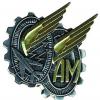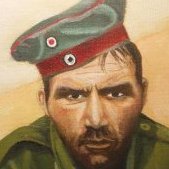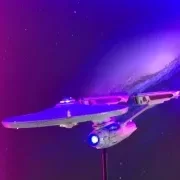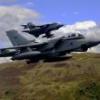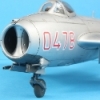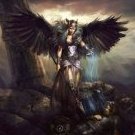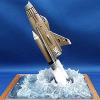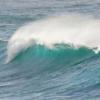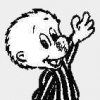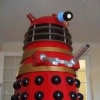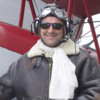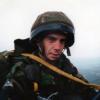Leaderboard
Popular Content
Showing content with the highest reputation on 14/06/17 in all areas
-
Finished this 1/72 Airfix Fiat G.50 today. Not sure what year my kit was from, I used a red stripe header bag release. It's entirely box stock with the exception of rescribing entirely with recessed panel lines and utilizing Sky Models aftermarket decals. I used a combination of Life Color, Italeri and Tamiya acrylics for paint. Also an artists oil panel line wash. It's a simple kit that was pretty cleanly molded and didn't require a great deal of fettling or filler to get ready for paint. Can't speak to accuracy, but I think it looks the part pretty well.28 points
-
Hi Here is another finished build with this Russian Navy Sukhoï Su-33 fighting over Syria in December 2016. This is a 1/72 kit from Zvezda and she should be published in Tamiya Model Magazine French Edition. Patrick19 points
-
Well I have finally put an end to this build. Brilliant kit but I have been frustrated by my own ineptitude with turnbuckles! In the following photos I have tried to capture, to the best of my ability, the finished model and some of the fine details. Propellor, boss and engine panels are only sitting in place and are not fixed so that they may be removed to show engine detail. In the pictures I now see that some of my turnbuckles are not quite in line but these are easy enough to fix by tweeking the wire with tweezers, on the other hand I can't do anything with the messy twisted and glued ends of the EZLine but the don't look nearly so bad at 'actual size'. As to the kit, I can't fault it, brilliant! As to my skills ...weeelllllll........let's just say 'Could do better' particularly the lozenge. I found trying to get that neat and tidy a very difficult and time consuming task. Numerous times I tried to move on too fast before a decal had set, finished the next piece of lozenge or rib tape only to discover I had unwittingly mucked up the previous decal. I am looking forward to trying one of the WIngnuts kits with the pre-shaped lozenge. My turnbuckles, I just don't know, they are too big for scale even though they are the smallest I could make at 0.4mm outer diameter and, no matter what I do they will never be truly accurate representations of the real thing. I am thinking that I might just go for a touch of silver paint on the ends of EZ line in future. Anyway I hope you all like it and, as with my Sopwith Camel - If I can build this kit and not be totally ashamed of my results then anyone can make a great model from a Wingnut Wings kit Give in, you know you want to17 points
-
Hi guys, I'm not usually an aircraft builder however I decided to incorporate a diorama into this build and have a go at adding an electric motor to one of the engines, also this is my first attempt at modelling a grass base. I wanted a patchy and worn looking effect where a lot of work seems to have been carried out under the plane and the grass has suffered for it. I hope you like the results.13 points
-
Hi everyone. Here is my attempt at the new Airfix Stuka. A very nice kit and I enjoyed building it although I had a disaster towards the end, I managed to spill white spirit all over the rear canopy, which fogged it immediately. Not to worry I thought and set about polishing it out only for it to crack multiple times during the process. Not to worry, I thought again, I'll contact the nice chaps at Airfix and buy a replacement, but unfortunately the reply came back 'we have no more canopies in stock... sorry' So rather than giving up on it I decided to leave it as it is and claim that it had a nasty brush with a Spitfire! Or until at least an alternative replacement can be sourced. For this kit I used Xtradecal sheet X48164, this particular aircraft is from 6./st.g 77 circa 1940. Painted with Xtracolor enamels and weathered with pastel chalks and oil washes. The only additions I used were seat belts made from Tamiya tape, I also used Eduard masks for the canopy (highly recommended), plus a little extra riveting here and there. Thanks for looking, gazza l13 points
-
Hello, the beauty is finished ... I love the Mosquito as one of the most beautifully shaped airplanes ever.... she has a kind of elegance in her shape ... Kit is from Tamiya in 1/32 with many, many parts, great fit, great quality, great details, great manuals, great ..... a fantastic kit of a huge model! I have added some photo etched parts from Eduard, some new decals for the stencils and markings (Canadian Airforce with beautiful nose art) and some resin parts. Painting was done with Lifecolor-colors mainly, plus AK Interactive. Weathering with oil colors, pigments, ... I hope that you like it! Cheers Micha11 points
-
The Spadgent has started a build thread on this venerable but in my opinion, very good, kit. I built this some years ago after I had returned to the hobby after a 30+ year break - it was the third kit that I tried. I had built one of these when it was first released but did not have the skill or patience to do it justice then. I bought this second hand in the late 1970's so it was in dark green plastic and had no flash - just all of the ejector marks! I threw away the glazing and replaced it with clear acetate sheet and had to mould the upper wing centre section top (mine was missing and Airfix only re-released the kit after I had completed it). I hand painted the cockades, fin flashes and letter on the nose. The serial is from transfers as are the lift here markings. I also built the kit in a completely different sequence to the instructions because I knew that the wing joints are very tricky and care and dry runs are needed if that particular operation is to be successful. This represents a machine from an RNAS unit in early 1918 and was used for day bombing. It is worth remembering that at the time this kit was released it was one of the best quality kits on the market, which shows just how far our hobby has come in the intervening years. There are three other photos on The Spadgent's build thread page. The model is rigged with clear monofilament thread - it nearly drove me bonkers as it was almost impossible to see!. It required drilling lots of holes, (the holes provided by Airfix in the wings are a bit of a joke), and there were some other issues which I had to deal with. There is a build thread for this on Airfix Tribute Forum and an article on Modelling Madness if anyone is interested. I added the ladders and other bits just to give it a bit more interest. I know that the tail dolly is a work of fiction on Airfix's part but I could not find suitable photos/drawings at the time to scratch a proper one. In all an interesting build and one that I had long wanted to complete. It was also one of the last kits that I built as I found two completely forgotten, incomplete conversions in my roof when I was building this and looking for something else.... and so I completed them and continued with other conversions which I had also long wanted to make, and now I scratch build. P10 points
-
Edited using Postimage. Several years ago I flew in a Corsair simulator at "Flights of Fantasy" in Florida, and I have loved the aircraft ever since. Consequently I thoroughly enjoyed building this one, went together like a dream. I now prefer to build my aircraft " wheels up" but as Revell do not include pilots I had to put this one on its undercarriage (any recommendations as to where I can get hold of aircrew in all scales and era's would be welcome). Paint used was Tamiya Royal Blue X3, a couple of coats of Pledge prior to decals and then sealed with Tamiya Semi Gloss Clear X35. I look forward to your comments.10 points
-
A quick preview of my latest kit finished in time for the end of the F-111 Group Build which finishes on the 2 July. More photos in the gallery (and other completed builds) of the GB thread as well as the WIP. Thanks for looking and comments welcome.10 points
-
10 points
-
Hi, I finally found time away from resin to complete this build of one of my favorite color schemes, not to mention the story of the one kill VF-111 scored during the Vietnam War. The build comprises the following with many scratch built parts, pattern creations used to create resin parts, and some top flight accessories from the community vendors. Items Used: Tamiya 1/32 F-4J kit GT Resin F-4B/N Conversion Set GT Resin Intakes and exhaust GT Resin Sparrow Missiles Zacto Model Sidewinder Missiles Master AOA and pitot tubes Part R Us engine details Zotz Decal markings and Stencils Two Bobs AIM-9 missile and AIM-7 decals Eduard F-4C and J Interior, exterior, Seat Belts, Masks9 points
-
Hi Folks Another Meteor I am afraid,this one has a little bit of history to it as according to CWS Vol 1it was the last Meteor F3 in operational service. This aircraft served with 500 Sqdn until almost the end April 1952 by which time 500s Meteor F4s had been replaced with F8s. It is also unusual in having the Squadron code in front of the roundel. Decals were from generic sheets and it was painted with Xtracolor HSS Ian9 points
-
I didn't consciously decide to go on an old Frog kit building frenzy. Or, at least I don't think I did. Regardless, here's another one. This time it's the 1977 Novo release of the 1974 Frog Lavochkin La-7 in 1/72nd scale. I've built it straight out of the hang card bag with the exceptions of a total rescribe with recessed panel lines, the addition of a bit of plastic card to block off the main wheel well and employing a very nice set of Authentic Decals printed in, rather ironically, Russia. I cannot speak to accuracy as I didn't bother to check but it looks rather like the La-7 photos I've peered at. It's a simple kit but pretty cleanly molded and didn't require a great deal of fettling or putty to get it paint ready. I went with Vallejo Model Air colors for the camo and Tamiya for the rest. Both always go on very well, especially over Stynelrez primer which seems to bond so well to the plastic and the paint to it. Oh, and I used some Bare Metal Foil for the strips around the cowling. I also tried the artist oils wash technique for the first time. It's a bit subtle on this particular job, maybe used too dark a brown, but I quite like the idea and will be using it more often for sure.8 points
-
Wowza you guys have been busy. All that research you are doing for me is invaluable I can't thank you all enough,The back story of Major Kieth Park especially has made this even more compelling for me as well as the build, there was only a snippet in the windsock data file I have so this stuff is fascinating. 66mph . I think I'll sand the ribs back and see what I have left. I might add the tape lines too. Bringing back memories of @TonyTiger66's wing rib nightmare is not somewhere I'd like to go so I'm still looking to keep what I can. Oh and @pheonix Your 0/400 is amazing, if my one turns out anything like that I'll be over the moon. Those ladders are ace, were they scratched? Talking of scratch building, how ace is that 1/48 0/400? Glad to hear of the Aerosmith love too, it will be their last U.K. Gig So I had to see them again one last time. it's been a rotten day at work today so I tried to get some Modelling done to calm my bones. Bad idea. the milliput hadn't set, I must not have put enough of the second part in, so after blabbing around with half dry MP I scraped it all out and tried to sand off some of the planks stupidly using the metal rod end of the coffee thing as the MP hadn't set. Bad ide number two. It worked for a short while but as I was blasting away at it I didn't notice what a shoddy job I was doing, lumps, bumps, holes, scratches. honestly don't model in a grumpy mood. No pics of the horror as I just ploughed on and tried to fix as best I could, I used Mr Surfacer on the damaged floor part and glued plasticard in the gaps. not too bad, most of not all of the wobbly bits will be under the seat and mid join anyway. I blasted some primer to check all was well. Im happy with that, it's representing wooden planks anyway so I'll take What I can get today. I did start on getting rid of the pin marks on the main fuselage, one side done and blasted with a smidge of primer. pretty good. I've added some Mr S and I'll have to re instate the lost wires but I'm going to end it on a high. If I carry on I know I'll put my foot in it. it looks as though Photo Bucket is playing up and the pics aren't showing so more reason to go to bed and say bye to today. if they work cool, if not I'll try and fix em along the way. Thanks again for all the interest in this Big CrAzY build. it warms the soul knowing you're all out there. Take care and happy moddeling chums. Johnny. ps. Photo bucket is fixed so i fixed it. Yay!8 points
-
Ladies and gents, my first RFI on here..... If I'm honest I sort of lost focus on this a bit due to my own kack handedness and bad skills. However, you couldn't mistake it for a 109 I may try and add some rigging after the superglue has set on the mast as there was no locating pin hole in the canopy and since I managed to split it when fitting maybe left as is7 points
-
日本航空自衛隊 第6航空團 第303飛行隊 小松基地 創隊60週年紀念塗裝 2014年9月 第303飛行隊(だい303ひこうたい、JASDF 303rd Tactical Fighter Squadron)は、航空自衛隊第6航空団隷下の戦闘機部隊である。小松基地に所属し、戦闘機にF-15J/DJ、連絡機にT-4を運用する。 JASDF 303rd TSF F-15J Eagle "60th Anniversary", September 2014 Komatsu Air Base.7 points
-
Hi All, Here is my latest build. A super-fast palate-cleanser in between more involved projects. This is Hasegawa's 1/48 Bf109G-6, boxed as a G-14 and finished with Mr Color paints and kit decals. A full-build article is here: https://jonbryon.com/hasegawa-148-messerschmitt-bf109g-6/ Comments welcome. Thanks Jon7 points
-
Hi all This time even more uninteresting model, Italeri 1/72 RQ-1 Predator. Nice little model, with no issues, small number of parts, very boring color scheme, small amount of decals......no external load...so ...very anemic As i wanted all three from this family, he was finalized also and took his place in cabinet. Only what was really interesting for me is comparison of sizes of those drones......showing how technology is changing thru the time. So pictures and at the end family pictures. I hope you like them. Best regards7 points
-
Avro Vulcan B.2 Scampton Wing 1970's This is the 1/200 CyberHobby 'Blue Steel' boxing of the Vulcan B.2, recently completed for the 70's NATO v Warsaw Pact Group Build. There was a small amount of scratch building to make some bomb bay doors to turn it back from Blue Steel to a Free Fall B.2, but apart from that it was built OOB. I hope that you like it. This was the conversion work carried out to switch back to a more conventional role. And a final shot to give some idea of the size.7 points
-
Hi everyone, This is hobbyboss 1/72 f-22 raptor, which looked like it would not take long to build. I wanted to build it wheels up as I think the raptor looks better in the air then sitting on its under carriage. But as there was no option to build it this way or with the missile doors shut I had to bodge ( sorry, ' scratch build ' ) the doors for the missile bays etc. I used xtracolour enamels for the greys with some humbrol polished aluminium metalcote mixed in. The canopy was my first attempt at tinting which I used tamiya smoke and titanium gold mixed with clear. I do not know how accurate hobbyboss rendition of the raptor is but it looks the part to me. I enjoyed this build as I quite like the raptor having seen it last year at riat. Apologies for quality to photos, taken on phone. Any comments good or bad welcome. thanks matt7 points
-
Su-35 Flanker E 1:48 KittyHawk Simply put, the Su-35 is an updated Su-27, but as is often the case with Soviet/Russian aircraft development, the gestation wasn't linear, and included a still-born Su-35 with canards of which only a few examples were built. Second time around the design was changed to remove the canards as they were no longer needed due to advances in aerodynamics, which also allowed the designers to reduce the radar cross-section of the airframe into the bargain, leading to claims of the design being gen 4++. The aircraft also took advantage of thrust vectored versions to improve its manoeuvrability, and as such sits in the gap between the Su-27 and the forthcoming fifth generation Pak-Fa, or T-50 as it is also known. A complete overhaul of the avionics was included in the re-vamp, and more modern materials were used in construction to provide enhanced capabilities as well as more durability in service. Its engines are similar to those of the Pak-Fa, and have an extended service life and significantly higher thrust that should allow it to supercruise, which seems to be de rigeur with modern jets, and will certainly lead to better fuel efficiency. Around 50 aircraft were ordered initially, ramping up production as the years went by, and another 50 were ordered later to bring the total up to almost 100 once deliveries have completed. China has also ordered a number for testing and development to gain experience in operating thrust-vectoring airframes before their own 5th gen project reaches fruition. Other buyers are in negotiations, which could result in the Su-35 being quite a success. The Kit A brand new tooling from KittyHawk, who have done their best to make it the best Su-35 in 1:48, taking on board criticism and support from the modelling community through its gestation period. The kit arrives in a traditional top-opening box, and you guessed it, it's full of plastic. Not brim full, but you'll struggle storing much aftermarket in there. The sprues are all bagged separately to protect them, with the two main fuselage parts together on the top of the rest. The styrene is all the usual KH pale grey and there are another eight in the same colour, a clear sprue, a sheet of Photo-Etch (PE) brass, and three decal sheets of varying size. The booklet is sub A4 with colour painting and decaling guide folding out from the centre pages. As with a lot of modern fast jets, the construction begins with the ejection seat, which is very nicely detailed straight from the box with an ejection seat that is made up from a substantial number of parts, includes some rather better seatbelts than previous kits, with decals for the side consoles and instrument panel. The complex HUD has two clear panes, and a PE hood over the top, which should result in a great focal point with careful painting. There is some confusion as to whether the seat is the correct one for the mark, but I will endeavour to take some close-ups of the parts, so that those that know can check. This and the gun insert are added into the upper fuselage along the refuelling probe bay, while in the lower fuselage the main bays are built-in using individual panels for added detail. The nose gear bay is constructed into a curved roofed box, and that fits into the nose of the lower fuselage, held in place by some quality bracing Ls in the corners. The exhausts are next to be installed, after being built and painted. The aft sections are made up from two detailed cylinders, with commendably thin lips, while the forward section is built from two halves, into which the rear engine face and afterburner assembly are fitted. Once both are assembled, each exhaust is surrounded by a shorter set of petals and then dropped into the lower fuselage before being enclosed by adding the upper. The Su-27 family all have pronounced stingers between the engines, and the -35 is no different, made up of two separate parts that fit into the rear fuselage and are joined later by an open or closed parabrake fairing. The gun trough is also completed by an insert with the busy mesh venting well depicted. With a blended fuselage, the wings are always smaller than conventional arrangements, and the wings here are made up from top and bottom halves, plus separate leading edges and flaperons. The wingtip rails aren't added until much later in the build, leaving the tabs visible in the meantime. Two more tabs at the root ensure a good strong joint with the fuselage, but as always test-fit before you apply the glue to get the best joint you can in this prominent area. The elevators are of the all-moving type, and are slim enough to be moulded as one piece, with only the hinge cowling a separate part, fitting into the aft of the wing-blend on a single peg for each one. The stabs are single-thickness for most of their height, with an additional layer below the separate rudder at the root. A number of tiny sensors are embedded in the trailing edge above the rudders, with small optional parts supplied for each one. Unusually, the canopy is shown installed with its interior detail parts and big IRST bulge in front of the windscreen, plus a choice of stowed or deployed refuelling probe, with the tiny AoA probes on each side of the single piece nose cone, which hides a full radar assembly, so perhaps you might want to leave it open? I said unusually, as the airframe doesn't yet have its engines finished, so there's a lot of work to do with the model flipped on its back, which never bodes well for the "fiddlies". The Flanker's intakes are widely spaced under the fuselage, and before they are installed, there is an amount of preparation, including placing the front engine faces inside, some detail parts for the main gear bay, a roof to each nacelle, a choice of open or closed auxiliary intake louvers, plus aerodynamically shaped "bumpers" for the gear legs. Again, check fit against the fuselage before you glue things in, as lining up cylindrical shapes always has an element of risk involved. Now for some wheels to allow her to stand on her own three (4 actually) shoes. The nose gear leg has a twin stack of tyres, plus the typical mudguard so often seen on these types, while the main gear legs are dressed with single wheels that have a simple single strut with smaller retraction struts. The two part main wheels have PE centres added, and have wall detail moulded-in, although the tread promised in the instruction diagrams isn't present on the plastic, but having seen more than a few Russian tyres, you probably won't worry unduly. Changing out part-worn tyres doesn't seem to be a priority for most squadrons! Each bay has its bay doors included, after which the pylons are added to the wing undersides, with PE sway-braces on each of the ten mounting points (excluding the wintips). Weapons. The Flanker D has a substantial carrying capacity, and following the avionics upgrade is cleared, or will be cleared to deliver a wide variety of munitions, and KittHawk have supplied four sprues for just such purposes. Take note, Hasegawa! It's list time: 2 x KAB-500KR smart bomb 2 x KAB-500SE/L smart bomb 2 x KH-29L/T Kedge Air-to-Surface missile 2 x R-73 Archer AtoA missile 2 x R-77 Adder AtoA Missile 2 x KAB-1500L/KR/SE laser Guided Bomb 2 x KH-31 Krypton Air-to-Surface missile 2 x KH-25-MT Karen Air-to-Surface missile 2 x R27ER/ET Alamo A-to-A missile 2 x R27-R/T Alamo A-to-A missile 2 x KH-58ME Kilter Anti-Radiation missile 4 x R-60 Aphid short-range A-to-A missile There are also a whole host of other weapons included on the sprues from iron bombs to sensor pods, which should be very useful if you're a frequent builder of Soviet/Russian aircraft. We're bound to see these used in a few more kits from KH for sure. As well as the missiles/bombs, all the required pylon adapter rails and carrier are included on the sprues, with the rear page devoted to showing you where the various munitions options fit. Check your references for real-world load-outs if you're going for accuracy though. Markings With three individual decal sheets provided in the box, and six painting options offered in the central glossy pages, you can bet there are some colourful choices, and you'd be right. Three of the options are dark grey over light blue, which includes two Chinese options, while the rest are all shades of blue in either freehand or splinter patterns, which can look superb when carefully done, so let's see what the options are. From the box you can build one of the following: Russian Air Force Su-35S Red 05 – dark grey over light blue. Russian Air Force Su-35 Red 31 – mid, light and pale blue came over light blue, with dark grey on the leading edges of the elevators. Russian Air Force Su-35BM 902 – Light blue all over with dark blue and white splinter camo. Chinese Air Force Su-35 – light blue all over with mid and pale blue wavy-edged camo. Chinese Air Force Su-35 – dark grey over light blue, with Chinese flag on the fuselage sides. Chinese Air Force Su-35, Cang Zhou Flight Tes & Training Centre - dark grey over light blue, with Eagle wreath motif on the fuselage sides and tail fins. There are a further four pages devoted to the painting and decaling of the weapons, their adapter rails and pylons, which takes up the larger of the three sheets. The rest of the decals are supplied on the mid-sized sheet, including a great many of the sensor patches, while the badges and instrument panel decals are printed separately by a different method on the small sheet. The decals are printed in-house, and on first inspection are of good quality, but under magnification there is a slight misalignment of the white base, which will show up most in the red numerals with white borders on main markings sheet. Check your box before you start, as some spare numerals may be required, depending on whether it bothers you or not. Otherwise, registration on the other sheets is good, the decals appear crisp and have good colour density. Conclusion A comprehensive box of Su-35 goodness that will doubtless find its way into many stashes. Given the sales already made and the possibility of more in the future, coupled with the consensus that it is a very capable aircraft, we're going to see a lot more of the Flanker E in the years to come. The kit shows a lot of promise in terms of detail, and as long as you test-fit the assemblies together before you get glue-happy, it should build up into a fine looking model with a little paint-and-patience. Highly recommended. Review sample courtesy of and available soon from major hobby shops6 points
-
On the 12th August 1941, a force of 70 bombers including 9 Manchesters with 6 from 207Sqn based at Waddington and the other three from 97Sqn took off on a deep penetration raid to Berlin. The Manchesters were carrying mixed loads. Some carried the 4000lb Cookie whilst the others carried 5 x 1000lb GP's. One of the aircraft L7380 (EM-W) which was later captured on film by the Germans having crash landed on sand banks in Holland had to turn back over the North sea due to poor performance and tail flutter. It landed successfully back at Waddington after dropping its bombs on the port at Emden. The other 8 continued on. Over Holland, L7306 of 97Sqn was attacked by a night fighter but successfully evaded it by taking cover in cloud. With all gunners on look out for further fighter activity, Mike Lewis flying L7422 (EM-V) was flying with another Manchester in front of him. Suddenly, he noticed tracer striking the Manchester. Immediately, there was a large pink flash, clear evidence that the Cookie had exploded disintegrating the aircraft. The remains were seen failing away in a shower of yellow flame as the fuel tanks exploded landing around Kolham. Mike Lewis learned that the Manchester was L7381 piloted by his good friend Mike Smith who was on his 50th mission. L7381 had been brought down at 01.25am by Oberleutnant Ludwig Becker flying a Do215 having been tracked by his Liechtenstein set. The remains of mike Smith were found in a ditch still strapped in his seat. The only consolation that could be taken is that the crew suffered an instant death. The crew were recovered and laid to rest in the cemetery near Hoofdweg at Kolham, but were subsequently relocated to the Canadian war cemetery at Holten. The build is the new Airfix Lancaster II with the Blackbird Manchester resin conversion. Having been inspired by the book 'Avro Manchester - The Legend Behind the Manchester' by Robert Kirby (where most of the research above was taken from), I wanted to do a tribute to one of the many tragic accounts covered in his book. I decided on L7381 that fitted the bill in that it had the wavy demarcation scheme and of course had the three tails of the early Mk.I. Part way in to the build, I decided to do a diorama that involved the 'fateful' cookie that led to the demise of Smiths crew that night. The engraved plate was picked up for a fine sum of £1.75 off Ebay which you can't grumble with. The ground equipment was taken from the Airfix Bomber Re-supply set. Whilst there are no known photo's of L7381, there are plenty of L7381 to which I used for reference. Robert Kirby introduced himself in the build thread and pointed out a mistake in the build in that I used the narrower 28' tailplanes where as all but the first 20 Manchesters used later 33' unit that was standard on the Lancaster except for the three tail configuration. Take note of this if you are thinking of building one, for me, they are too secure to think about changing, so I'm playing ignorant! I want to get some more ground crew, so will add them at a later date to the diorama, but for now want to clear the bench. I'm not going to go in to detail about the build as it's covered HERE, so I'll get on with the pictures. Thanks again, for all the people who have followed and contributed throughout the build Thanks for looking Neil6 points
-
Another in the seemingly endless stream of P-47s coming from the 72 Land production facility (we're over 25 now). This is the Academy kit, with Kits World 72-132 decals. As always from these producers, the kit and markings performed without drama. The plane belonged to the 342nd Fighter Squadron, 348th Fighter Group, 5th AF, and was piloted by Commanding Officer Lt Col Robert Rowland in 1943. He survived the war and was credited with 8 aerial victories. I am fairly happy with this one, no doubt due to my experience in building P-47s. Though I noticed one gear door escaped the scene before the photo session. Now I've got to find the freakin' thing... This is completed aircraft #476 (9 aircraft, 2 ordnance, 7 vehicles for the year 2017), finished in June of 2017.6 points
-
I have recently arrived back from a 5 week course in Toulouse and now can chill and get down to some modelling again. Before I left for France,I had completed a quick 3 day build of a couple of Impalas, but didn't get the opportunity to photograph and post them up here. Well here they are.... I hope you enjoy. The Impala (5 Sqn, AFB Durban, SAAF) was the first jet aircraft that I flew and as such I am particularly close to these individuals. Shortly I will be focusing on the larger 1/48 scale versions that these were the practice for. The Mk1 was painted using Alclad II and the Mk2 painted with Tamiya acrylics. They were a fun build and went together well with minimal filler and sanding. The only issue was re-scribing the raised panel lines but it was good practice and only time consuming. I found it far easier to scribe the panel lines before building the kit. Mark6 points
-
Hello modellers! Today let me show you my new F-104G Starfighter in 1/72. It depicts a German Airforce Starfighter from Fighterbomber Wing 31 “Boelcke” in Nörvenich from the late seventies. Despite the fact that the Italeri Starfighter is less detailed that the Revell or Hasegawa models, I like the kit as there is no option for a two-seater, making assembly of the fuselage a lot easier. As it is the second G-model I built from this brand, I knew very well what to improve. I scratchbuilt a new ejection seat as the Martin Baker seat from the kit was too small and nearly disappeared in the cockpit. The undercarriage was detailed with silver rod and stretched sprue and the characteristic bulges in the main landing gear doors sculpted with styrene sheet. Slats and flaps were cut and glued in extended position. Navigation, taxi and landing lights were added as well as collision warning light from sculpted rhinestone. The small stall warning probes were scratchbuilt from rod and aluminium tape and a new pitot tube was made from brass tube and silver rod.. The paint scheme was easy to apply as there are Revell enamels that matched the colors without the need of mixing. Gloss coat was Gauzy and matted with Tamiya acrylic paint. The decals from the box were very nice and worked perfectly. Found two very helpful sources in the web for a proper Starfighter build: https://www.youtube.com/watch?v=aKv9lsdln7E http://www.rolfferch.de/F104G/ Hope you like it Mario5 points
-
I began this build in the Hour of Longing in 2013, but for various reasons it got put to one side until a couple of weeks ago where I decided it had been on the shelf of Za'had'Doom* for too long. Its a resin kit from Warp and as such isn't an easy thing to build. The casting is - to be honest - a bit ropey, the moulds are probably getting old and it does show in places. Original build there is here * Yes I know I spelled it wrong deliberately! ...and so we arrive at the Hour of Scampering... We have always been here... The central accommodation section does rotate, but its NOT motorised! See, told you so! The red spots are emergency lifeboats So there you have it. I'm going to enjoy having this on the shelf next to the Sulaco from last year It'll be doing the show tour for the rest of this year, next scheduled one is Romsey and Smallspace in July...5 points
-
Airfix 1/72 benevolent fund hawk,nice little kit.Every thing went were it should do except for the canopy which still needs a little more paint and two tiny probes /antenna Which has found a loving home in the outside bin.No real problems that couldnt be fixed ,except for the white decal.The minute you leave the transfer paper they disintegrate.Not all of them just the longer ones so ended up painting most of them on.Thats about the only problems i had with this build apart from that its a nice little hawk.Dont know why i was fretting about this one. Onwards n upwards. 1 by skellitor59, on Flickr 2 by skellitor59, on Flickr 4 by skellitor59, on Flickr 5 by skellitor59, on Flickr 6 by skellitor59, on Flickr 7 by skellitor59, on Flickr 8 by skellitor59, on Flickr 9 by skellitor59, on Flickr 10 by skellitor59, on Flickr 11 by skellitor59, on Flickr 12 by skellitor59, on Flickr 13 by skellitor59, on Flickr 14 by skellitor59, on Flickr 15 by skellitor59, on Flickr 16 by skellitor59, on Flickr IMG_2066 by skellitor59, on Flickr5 points
-
But of what is that a proportion? What is it as a percentage? 15% 25? Do you really think that kind of difference cannot be seen? What is important is that it looks wrong. You want to build a model that looks wrong, go ahead and enjoy your modelling, but don't expect others not to care. There's no uncertainty about this difference: just what is so wonderful about being wrong? This is a difference that was known about in the 1960s - Frog got it right. The error has been introduced by laziness: lack of research, lack of observation, coupled with mindless copying of what went before. Pointing it out isn't new: it has been done several times before.5 points
-
That range looks most smart Ced. Such things are important to a chap. Being singularly prone to 'a touch of the sun', Mrs B ensures I remain well covered-up in cosplay headgear: That way when we holiday in England, it appears to my countrypersons as if she is being accompanied by an extra from Assassin's Creed... That is extremely sweet Ced. ...or else: ' so little kit going into this work' ! Cheers John. Nice to have you back. Scarcely a glamorous couple of days sanding and shaping so I refrained from posting any pictures until there was anything significant to show you. I think we're at the stage now where the basic shaping and equalizing part of the process is nearly complete: If you recall the last photo update saw the upper regions at the back taken care of, so the next part of the process was to continue the dinminishing curve on the upper corners down to the 'beak' at the rear, as you can see above. That done, it was time to flip the piece over and work on the (less-drastic) curves to the lower regions. Port: Starboard: Again the carpenter's square/sandpaper method was invaluable in reducing and matching profiles between both sides of the aircraft - especially as there was an errant 'hump' on the underside that needed some attention to get right. This part of the process was quite time consuming additionally as with the gentler curves on the undersides: ..it would be easy to get carried away with the file, so restraint was the order of the day. The proof of the pudding is really in the rear aspect view, as any lack of symmetry between either side, or irregularities in the curvature would leap into view: We're in the final furlong of this process I feel from looking at that. I want to tidy that up some more and add a little filler to some of the repairs, with the intention of a test shot at the weekend. The plan at the moment (have I mentioned this already?) is to split the buck into an upper and lower section for vacforming, so than neither section is higher than 25mm. That's the plan anyway. Thanks for looking. Tony5 points
-
A Blackburn Pug? The mind boggles at something that would have had a huge radial engine and squat little body with tiny undercarriage...5 points
-
Neighbours are we ? Sorry to p*ss on your bonfire but diorama already decided, so take your 'sports equipment' and push off Should have left it at this point ' anything ' being the key point Sorry for the lack of progress here at the moment. Work is getting in the way .............. I'm supposed to be retired What little I'm doing is to try and find a way of doing something even more ridiculous than usual (Enter the Martian) Normal service will resume Kev5 points
-
I had a weekend away at the Sovereign Hobbies secret base, hidden in an old volcano in Aberdeenshire, but before I left my Shapeways 3D printed stuff arrived - I was very impressed with them and gave them the suggested soak in soapy water overnight, then left them on the window-sill to cure fully while I was away. It's best not to rely on their being consistent sunshine in Scotland at this time of year but I think they got enough UV. Here they are: The 4.5 inch gun, which will require some assembly: The 'square'-type gunshield that I ordered in error: ... and the curved gunshield correct for HMS Bluebell that I ordered to replace it: The ready ammunition for the 4.5 gun: ... the twin Lewis Gun installations: ,,, and finally, my favourite, the 2-pdr Pompom: I remember reading a few years ago a question as to whether 3D printing would ever have a useful modelling application and I think on the strength of these parts we have actually got there. The delicacy of the pieces and the quality of the printing exceeds what I had expected by quite some way. The only problem is that now I am thinking I need to replace the Hedgehog rockets, the depth charges and the Oerlikons so it looks like it could become a bit pricey. On my trip to Aberdeen Jamie of Sovereign Hobbies was able to sort me out the (probable*) correct colours for the late camouflage scheme for HMS Bluebell as depicted in the Matchbox kit, MS2 Dark Grey, MS3 Medium Greenish Grey and MS4 Warm Light Grey: As usual my camera has failed to capture the subtleties of the colours but as a rough guide, MS2 Dark Grey (RN05 above) is similar to RAF Ocean Grey but a bit lighter and slightly less blue, MS3 (RN06 above) is like a paler, more greyish RAF Sky and Warm Light Grey (RN12 above) is like a paler less saturated version of RLM02. I hope once they are applied they will cover a wide enough area to photograph a bit better. I'll be doing the decks in another RN dark grey and I got some IJN Deck Tan (IJN09) for the wooden parts of the deck. Apologies that this has all been a 'look what I bought' thread instead of a 'look what I built' thread, I hope to get back to the construction shortly Cheers, Stew * 'Probable in the sense that there is, as always, some debate about this, but I can't remember what the other colour candidates were. Sorry5 points
-
5 points
-
If you can scratch build a Manc like the one you did, the conversion will be a walk in the park Ian. Is it the Blackbird conversion you have? Got some photo's of the interior done just now. The interior was painted with Vallejo Panzer Grey primer then overcoated with a mix of Tamiya cockpit green lightened with some white. Various bits have been added using plasticard, I'm loathed to buy all the detail sets you can get when most of the interior is hidden. The only Eduard parts I've used are the instrument and side engine control panel Cheers Neil5 points
-
Hi everybody; WE progress report airing on Tuesday - very busy day yesterday at work Little time for modelling last WE; I went to a local model show in Cremona on Saturday where I met Silvano ( @phantom61 ) and Eugenio ( @72linerlover). Great to meet you there, guys! Eugenio brought along a Macchi C205 in 1/72 he made a few years back ( ) which is a little gem, with engine, machine guns and wheel bay details and removable engine covers - crazy small parts in that scale! Many outstanding models in general, I'm eagerly waiting for them to upload the show report on their website Back to the update: wing dihedral for the C202 Installing the water radiator: I first masked the corresponding fuselage area to spray some Lifecolor Grigio Mimetico, as I think it would have been very difficult once the radiator is in place here it is after primer and a couple of Grigio Mimetico (Lifecolor Dark Gull Grey) coats I did the same for the radiator cover internal part and for the front and back lips The radiator itself received a black tempera wash: and was then glued in place with CA Cover is on; I used CA inside, where it mates the bottom of the radiator, and Tamiya Green Cap along the edges touching the fuselage Some filling is required here, as the reference pic show a very smooth area, with some sort of fairing from the radiator cover to the fuselage. Same on the other side, although less "gappy" There are a few more tasks to be accomplished prior to priming the model, one of which is scratch building the wingtip navigation lights; so I cut out the plastic ones and glued in two bits of clear plastic, using CA gel The light bulb was reproduced drilling a 0.4mm hole in them and brush painting some Tamiya Clear Blue and Clear Red, sealed with a drop of Future The idea is to leave this cure for a couple of days, then start sanding the clear plastic back to shape and polishing it - tonight's job, probably I've also started working on spinner and propeller, cleaning the parts The spinner plate mounting peg is designed to be inserted into the fuselage prior to mating the two halves, so as to allow for a spinning propeller; since I couldn't care less for that, I decided to leave the mounting hole free, to be used to insert a supporting rod for the painting stage, and I modified the mounting peg cutting away the largest part Test fit and glued to the spinner plate Spinner and propeller dry fit, pretty good: Another dry fit of the spinner plate to the fuselage shows I need to sand flat the front fuselage area here you can see it better That's it for this WE progress report, comments welcome as ever Ciao5 points
-
Hi folk's,last in the trio of Hobbyboss easykit's for the From Russia with love GB,for it's type a great easy build much more refined than some in the range lovely panel lines and a canopy worthy of mention.In one of the schemes of Ivan.F.Pavlov hero of the Soviet union,I have not added the wire due to poor light and several pint's of Guiness last night and apologies for photo quality still using my phone.Thank's for looking in.4 points
-
Indeed... http://www.airliners.net/photo/Untitled/Caproni-Stipa/320209?qsp=eJwtjEEKwkAMRa8iWbsRwUV3egFdeIGQ%2BdTB2glJQIfSuxuLu8f7n7eQtDnwiXtX0EAONnnQnpSNX07DQk/0d7OSTMJqba47j6qcJ28Wl55D4cBZBBoof3%2B1AvtNcNl6Y/YPCbDbxnQ8pS/VdeKtgeA60bp%2BAePZMcg%3D Not radial-engined, actually.4 points
-
Hi Here is my completed Tamiya 1/48 Bf109-E7 in Romanian Markings... Thanks for looking Plasto..4 points
-
Not much from my build since the opening post, but i have made some photos this morning from the relative small start. Fuselage halves and the cockpit floor are together, detailed and painted. The fuel line was masked and sprayed yellow. The cockpit floor detailed and painted. It has received a dark wash on the RLM 66 cockpit gray. Detail painting and dry brushing will follow. The photoetched rudder pedals are borrowed from an Eduard Fw 190 kit, i don t install them there because they will get invisible after the fuselage is closed. They can be better seen in the 109. The cowling with the added gun inserts. Fit is perfect as well the look. One of these fine but incredible features of the Eduard 109s Note the rivets. The exhaust stacks, beautiful but not moulded open as in Eduards Spitfire series. It felt today that the aircraft mojo is returning a little bit, may i got some modelling on this fine kit in the next couple of days. Cheers Bernd4 points
-
Cockpit update; paint and more paint. The base paint was laid down for the most part in the last update. This next session has more of the details painted, plus the beginning of the weathering process. WARNING: This is picture intensive as there are a lot of parts to the interior. A wash was applied to grubby the interior pieces up. After the wash had dried, more of the details were picked out with either a fine tip paint brush or pencil colors. I found these 3 sets of AM placards and brass bits and bobs for 1/32 Allied aircraft. I found some placards and instruments that would work for the IP and radio. I added some placards to the IP for further detail I must say these are very small to work with, but they do provide some interest. A radio dial was added to the radio Now, I can start putting the pieces together to do the final stages of weathering. The bulkhead that goes in front of the radio, but behind the pilot’s seat was added to the pilot’s seat bulkhead. Say goodbye to a lot of the detail of the radio. The radio assembly was then added to the pilot’s cockpit floor. The radio assembly sits over the fire extinguishers. Next up the pilot seat and the side boxes were added to the cockpit floor. Now a curious thing happened as I was adding the seat and side boxes, I looked at the directions for guidance! I was sure glad I did as I discovered there is another part that needs to be added to the pilot’s cockpit floor. The directions show a part to be inserted in the floor, but it has no number assigned to it. Going by the drawing of the part, a multitude of sprues were searched looking for the missing part. I found it on Sprue G, part 7. It was inserted into the cockpit floor and painted to match the rest of the cockpit. The last thing to add is the IP panel. I must say again how impressed I am with the fit of parts and Trumpeter’s construction design. You can gripe about their random inaccuracy issues in shape, but really can’t fault them for how the design a kit to be built! Now the sharp eyed among you will have noticed that the pilot’s seat still does not have seatbelts. I still have not motivated myself to tackle the Eduard PE set yet. But, that next on the list to do. I also hope I haven’t made a mistake in attaching the seat prior to the seatbelts being installed. There are still some stains I need to make on the interior and some fine tuning of the detail painting and weathering. However, tomorrow’s modeling time will be dedicated to Rall’s 109 kit as I have let that sit too long without an update. And it also needs the seatbelts done!! As always, all comments are welcome.4 points
-
Calling this one done and posting it in the Gallery. I would like to say that this was an enjoyable build.....I would like to say that but I can't, this one is quite a pain but I still managed to "get'er done". That is a Revell E-3 in the photo beside it's mortal enemy, the Revell DH-2. Greg in OK4 points
-
Now I'm thinking you have a massive pin stashed away somewhere: Unbelievable stuff.4 points
-
The instructions show the cowling and the wings off whilst installing the engine, but I don't think even this would help. Never mind I think I've sorted out the problem with a bit of surgery, off with the front cowl. It was still a nightmare to get in, involving a few hours fettling and dry fitting... I think that will do. And now to stick it back together again, adding a plastic card shim to allow for the bit I removed. Thanks for looking, gazza l4 points
-
3 points
-
Just a tip, I found it easier to lose the moulded in rigging detail on the insides of the fuselage, sort out any ejector pin marks and the re-instate the rigging from stretched sprue. You will also find that the apertures for the bombs in the underside of the lower wing do not match the mounts provided n the kit for the bombs. I bottled this one and did the model with the doors closed. Martian the Helpful (or not, depending on your point of view)3 points
-
The exhausts were painted using various acrylics colours and weathered using Tamiya Panel Accent. Time for some body painting. I firstly painted aluminium (Tamiya Titanium) overall and corrected some issues observed. I also did a pre-shade using Tamiya XF-01 in preparation for the painting. That's it for now.3 points
-
Ooh, Gun - forgotten them. There was a period when Taking On The World was an ever-present on my ... I was going to say iPod, but we're talking late-80s, so probably Walkman!3 points
-
I have not tried this but I've looked at the kits with this in mind (have several Hase Gs and the Revell/Monogram C and G in the stash) and my personal view is that it is very doable. I'd go with Hasegawa as the Hasegawa G already has the thinner wheel well doors as shares the sprues with the J and CF kit that have these doors. The A/C wheels are not present but I've sorted this by making a rubber mould to copy the Revell ones in resin (and if you're going to try this conversion I'm happy to send you a pair). BTW, the Italeri kit also lacks the proper wheels.The Hasegawa kit is IMHO also superior to the Revell one and is easily available. The J box can also be used and this can be found from Japanese dealers at very good prices. There are then a number of smaller details to sort, like different panel lines and smaller intakes, my go-to reference is this webpage from Taiwan that explains these differences from a modeller's perspective: http://rexkuang.tian.yam.com/posts/38281637 Ok, everything is in Chinese language but pictures are very clear and the differences well illustrated. Speaking of Cs, when deployed to Vietnam they sported bulges for an RWR system. These are included in the Revell box, however the one under the nosecone is the wrong shape (those unde the tail are fine). I've been slowly scratchbuilding one of these to add to my Esci kit (started building this before finding the Revell one and decided to finish it anyway). Again, once it's done I'll make resin copies. If you're doing an aircraft without these bulges then you have one less problem The Revell/Monogram kit may be the easiest option for an A or a C, however it is indeed not that easy to find and IMHO the canopy is also not as accurate as the Hasegawa one. It is of course a pity that the Japanese company didn't add a C to their 1/72 line of Starfighters as they did in 1/48 scale, would have made things so much easier. I should add that I'm pretty sure I've seen such a conversion on the web, however I can't remember where and I can't find it3 points
-
Masked, DG on and touched up where needed. Gonna be tight but hopefully get there!3 points
-
Nae worries Ced, take your time. It makes a change to have a relaxed Build from your good self. Johnny3 points
This leaderboard is set to London/GMT+01:00




